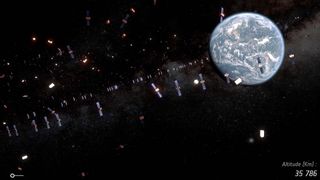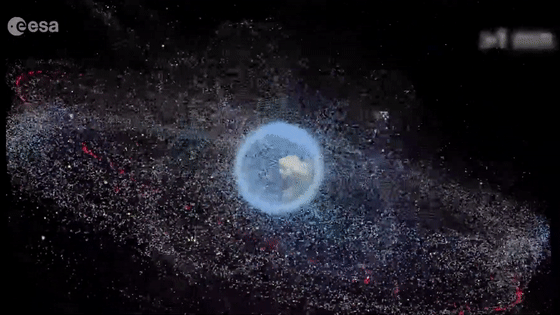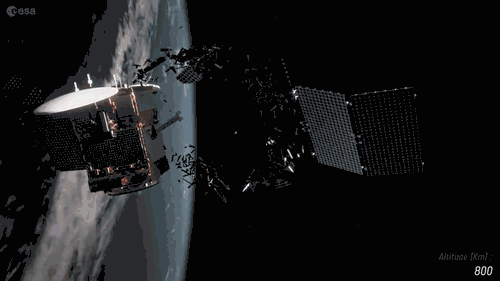How many satellites can we safely fit in Earth orbit?
"It's going to be like an interstate highway in a rush hour in a snowstorm with everyone driving much too fast."

Just 10 years ago, a mere thousand or so operational satellites may have orbited our planet, but there will be tens or even hundreds of thousands a decade from now.
Experts have been sounding alarm bells for years that Earth orbit is getting a bit too crowded. So how many satellites can we actually launch to space before it gets to be too much?
Jonathan McDowell is an astrophysicist and astronomer at the Harvard-Smithsonian Center for Astrophysics who studies super-energetic phenomena in the universe such as jet-emitting black holes in galactic centers. In recent years, however, McDowell has gained prominence for his work in a completely different field of space research. In his monthly digital circular called Jonathan's Space Report, McDowell tracks the growing number of satellite launches and the ballooning number of objects in Earth orbit.
The project started with an ambition to "provide a pedantic historical record of the space age," but has, in a way, become a chronicle of the environmental destruction of the near Earth environment. In his frequent media appearances, McDowell has been vocal about his views on the future of the increasingly overcrowded near-Earth space.
"It's going to be like an interstate highway, at rush hour in a snowstorm with everyone driving much too fast," he told Space.com when asked what the situation in orbit will be like if existing plans for satellite megaconstellations such as SpaceX's Starlink, OneWeb and Amazon Kuiper come to fruition. "Except that there are multiple interstate highways crossing each other with no stoplights."
Related: 6 types of objects that could cause a space debris apocalypse

Jonathan McDowell is an astronomer and astrophysicist at the Harvard–Smithsonian Center for Astrophysics. His main research focus is on black holes, quasars and sources of high-energy X-ray radiation in distant galaxies. He is a member of the team behind NASA's X-ray observatory Chandra, but has also gained prominence as a leading space debris expert. McDowell is the author and editor of Jonathan's Space Report, an e-mail-distributed newsletter documenting satellite launches.
McDowell has a Bachelor's Degree in Mathematics from Cambridge University in the U.K. and a PhD in Astrophysics also from Cambridge.
Maneuvers, maneuvers
The first signs that things are getting a little too tense are, in fact, already present. McDowell's British colleague Hugh Lewis is another frequently heard voice of caution, tempering the confidence of entrepreneurs caught in the new space gold rush. A professor of astronautics at the University of Southampton in England, Lewis has been for a few years now publishing regular updates on his Twitter page detailing the increase in so-called conjunction events, situations when two objects in space — functioning satellites or pieces of space debris — get dangerously close to each other.
Get the Space.com Newsletter
Breaking space news, the latest updates on rocket launches, skywatching events and more!
Some of his graphs are a sobering read. In a post published on Twitter on Jan. 13, Lewis stated that "the overall number of conjunctions predicted for 2022 was 134% higher than the number for 2020 and 58% higher than 2021, exceeding 4 million."
That, Lewis told Space.com, doesn't mean that on 4 million occasions objects in space came close to a collision — just that managing traffic in space is getting much more complicated than it has ever been in the past.
Take SpaceX's Starlink as an example. According to information that the Elon Musk-owned company submitted to the U.S. Federal Communications Commission (FCC) in December last year, SpaceX's autonomous collision-avoidance system performed 26,037 orbital avoidance maneuvers with its Starlink satellites in the two-year period between Dec. 1, 2020 and Nov. 30, 2022.
That means each Starlink satellite of the nearly 4,000 that have been launched to date performed, on average, 12 avoidance maneuvers during that time.
But the size of SpaceX's current constellation is less than 10% of what the company plans to deploy. Within the next 10 years, the number of Starlink satellites in orbit may rise to 42,000. Add to that the up to 4,000 satellites that OneWeb wants to launch, another 3,200 of Amazon's Kuiper craft and 13,000 satellites of China's envisioned Guowang system, and it becomes obvious that things are set to get much more heated.
According to the FCC document, SpaceX claims that each of its satellites has a sufficient amount of fuel on board to perform 350 collision-avoidance maneuvers over its expected five-year lifetime. But that number could be reached remarkably soon, according to Lewis' calculations.
"The number [of required avoidance maneuvers] is increasing nonlinearly." Lewis said. "By about 2027 or 2028, the Starlink constellation might have made throughout its lifetime a total of a million collision-avoidance maneuvers. And that also corresponds potentially to the earliest time when they reach 350 collision-avoidance maneuvers per satellite [per the five-year lifetime period]. We're talking about potentially hundreds, if not thousands of maneuvers a day."
In short, less than five years from now, Starlink satellites may be running out of fuel in a shorter period of time than their designed lifetime because of the sheer number of avoidance maneuvers they will have to perform.
Lewis, however, commends SpaceX for its attitude to space safety. The company, which only five years ago had not a single satellite in space, is now, with a substantial margin, the world's largest satellite operator. Since the launch of its first satellite in 2019, SpaceX has developed a robust attitude. The company says its autonomous avoidance system maneuvers every time a Starlink satellite encounters a situation with a 1 in 100,000 probability of a collision. This level of risk is an order of magnitude lower than the threshold used by NASA. SpaceX also assumes responsibility in every conjunction situation and performs a maneuver, unless operators of the other satellite involved in the conjunction prefer to do so themselves, the company told the FCC.


Hugh Lewis is a Professor of Astronautics at the University of Southampton in the U.K. and a co-director of the Centre of Excellence in In-situ and Remote Intelligent Sensing. He has worked in the fields of space debris and space sustainability for more than 20 years and is the author of the DAMAGE space debris model. Hugh represents the U.K. Space Agency at meetings of the Inter-Agency Space Debris Coordination Committee (IADC) where he chairs Working Group 2 (which is focused on space debris modeling).
Hugh has also represented the U.K. Space Agency at Scientific and Technical Sub-Committee meetings of the United Nations Committee on the Peaceful Uses of Outer Space (COPUOS) as an expert on space debris, space operations and space situational awareness.
Collisions
Operational satellites, however, are only one part of the problem. The European Space Agency estimates that near-Earth space is cluttered with some 36,500 pieces of space debris larger than 4 inches (10 centimeters), about a million objects 0.4 to 4 inches (1 to 10 cm) in size, and an astounding 130 million fragments smaller than 0.4 inches (1 cm).
The amount of the smaller stuff in particular continues to rise as larger objects collide with each other at enormous orbital speeds, producing clouds of fragments.
"There's good evidence that the number of minor collisions is already increasing significantly," McDowell said. "We're seeing debris from objects that shouldn't really be creating debris. They probably have been hit by something small, even if they carry on working afterwards."
While the larger debris fragments over 4 inches in size are regularly tracked, trajectories of the smaller pieces are mostly unknown, and the collisions they can cause come entirely without warning.
Debris experts, however, are most concerned about encounters between two large defunct bodies — dead satellites or used rocket stages. One such close approach, between a decades-old Russian rocket upper stage and a long-defunct Russian satellite, took place on Jan. 27. With neither object being able to maneuver, space traffic guards could only look on with their fingers crossed, hoping the two would miss each other. On this occasion, they did —by a mere 20 feet (6 meters). The incident, described as a close call "worst-case scenario," could have spawned thousands of dangerous debris fragments that would have stayed in orbit for centuries, threatening everything in their path.
The combination of increasing numbers of new satellites and the growing amount of orbital junk leads to a perilous situation that in the not-so-distant future may turn some regions of near-Earth space into a dangerous no-go zone.
"Things like [the Jan. 27 incident] will start happening more often," McDowell said. "One collision doesn't change things dramatically, but once we have one a year, you get to a regime where you start to have a lot of losses of satellites. It really will start to affect the economics of low Earth orbit. Companies will start losing serious money because their satellites keep getting destroyed."

So how many satellites can we safely fit into space?
So how many more satellites can Earth orbit safely hold? The answer to this question is not straightforward. Lewis says that certain orbital altitudes are more vulnerable than others. For example, Starlink satellites orbit 342 miles (550 kilometers) above Earth. Objects at this altitude usually don't remain cluttering space for too long after they cease operations. Even if their thrusters fail at the end of their missions and don't bring the craft back to Earth's atmosphere to burn up immediately (as many operators promise), these satellites' orbits naturally decay within a few years, thanks to atmospheric drag. This natural cleansing ability of Earth's orbit, however, declines with altitude.
"The space environment is like a system where you have flows in and flows out," said Lewis. "We launch things into space and the flow coming out, typically, due to atmospheric drag, is the only mechanism we've got really to naturally remove things from the environment. But above 1,000 kilometers [600 miles], the atmosphere doesn't really do anything, because it's so sparse. There's no sink; the numbers can only go up."
OneWeb's constellation inhabits this treacherous altitude range, and so does the smaller Globalstar.
Most megaconstellation operators pledge to ensure their craft have enough fuel left at mission's end to take themselves down where Earth's atmosphere can take care of things. But the likelihood of technical malfunctions still worries experts. In 2012, the European Space Agency, an outspoken champion of sustainable space operations, failed to remove its 8.8-ton (8 metric tonnes) Earth-observation satellite Envisat from its orbit 480 miles (772 km) above Earth. The craft, which will continue orbiting the planet for centuries, is now among the most dangerous pieces of space debris.
McDowell says that humankind is likely going to discover the natural capacity of near-Earth space "the hard way." Despite the pledges of megaconstellation operators, the astrophysicist doubts that things will remain manageable in the years ahead.
"Five or 10 years from now, we'll have somewhere between 20,000 and 100,000 satellites, and I am very skeptical that at the upper number of 100,000 things can be operated safely," McDowell said.
What next?
The question is, what happens next? Is the space industry, dazzled by the confidence of new space entrepreneurs, sleepwalking into its own version of climate change?
"The usual response of humans to environmental problems is to do too little, too late," McDowell said. "I think we are then going to try and scramble and do something at the last minute that maybe lets you carry on surfing the edge of a disaster."
McDowell sees a future where those interstate highways are finally going to receive stoplights, where overpasses get built and where traffic rules get implemented and enforced.
"I think that we'll see regulations to limit how many satellites you can have at each orbital height," he said. "Regulations to discourage elliptical orbits and force everyone to be in circular orbits. We're already seeing increasing support for a ban on anti-satellite weapons.
We may start to see actual penalties for debris-causing events — like, if you are careless enough to design your rocket so that it blows up accidentally, you might get fined for it, like for littering. That sort of change might then persuade the relevant manufacturers to be that bit more careful."
The precedent of more tightly controlled access to space already exists, McDowell added. Slots in geostationary orbit, the sought-after altitude around 22,000 miles (36,000 km) above Earth where satellites appear suspended above a fixed spot on the planet with a stable view of a large portion of the globe, are allocated by the International Telecommunications Union on first-come, first-served basis. In lower orbits, however, licenses are awarded by national bodies that have no obligation to coordinate with each other.
"I think that that will change," said McDowell. "As usual, as resources get scarce, governments will exercise more control over the allocation of those resources."
Experts are also calling on space agencies to develop technology to remove the most dangerous pieces of orbital debris. There is no business case for such a service so far, so the appetite is low. But an attitude change may be in the air. In July last year, the U.S. government published its National Orbital Debris Implementation Plan, which outlines steps forward to maintain order in Earth's orbit. Whatever happens, the status quo is unlikely to remain in place for long.
Follow Tereza Pultarova on Twitter @TerezaPultarova. Follow us on Twitter @Spacedotcom and on Facebook.
Join our Space Forums to keep talking space on the latest missions, night sky and more! And if you have a news tip, correction or comment, let us know at: community@space.com.

Tereza is a London-based science and technology journalist, aspiring fiction writer and amateur gymnast. Originally from Prague, the Czech Republic, she spent the first seven years of her career working as a reporter, script-writer and presenter for various TV programmes of the Czech Public Service Television. She later took a career break to pursue further education and added a Master's in Science from the International Space University, France, to her Bachelor's in Journalism and Master's in Cultural Anthropology from Prague's Charles University. She worked as a reporter at the Engineering and Technology magazine, freelanced for a range of publications including Live Science, Space.com, Professional Engineering, Via Satellite and Space News and served as a maternity cover science editor at the European Space Agency.
-
Helio Great article! I wonder what additional problems an active Sun will bring to this orbiting table?Reply -
Pogo Humanity is really bad at cleaning up after itself. Companies go out of business or move, they leave the buildings behind for someone else to worry about. Airplane crashes sometimes in remote areas, they’re left there. How many rocket bodies are in the Atlantic east of Florida, and everywhere else, not to mention ships. We have a war and equipment breaks, it’s just left there, not to mention unexploded mines and ordnance. And satellites die, we just leave them there. The owner of the satellite needs to be responsible for it from cradle to grave.Reply
